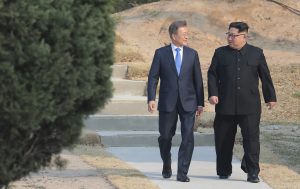By the time Kim Jong Un made the announcement as part of his annual public address on January 1, 2018, close observers would have been able to predict what he would say: North Korea was going to take part in the Winter Olympics to be held that February in PyeongChang, a ski resort town just across the border in the South Korean part of Gangwon province. In Kim’s words, the year of not only the Winter Olympics but also the 70th anniversary of the founding of North (and South, though for obvious reasons he didn’t mention that) Korea would thus be ripe with potential to “improve frozen inter-Korean relations” and “glorify this meaningful year as an eventful one noteworthy in the history of the nation.”
Though hardly unambiguous in its endorsement of South Korea’s existence, the news of North Korea’s active effort to restore inter-Korean ties was widely welcomed, marking a refreshing change from one of the rockiest periods of recent memory for Pyongyang’s relationships with the outside world. From the first days of 2016 through the late autumn of 2017, an aggressive North Korean leadership had made dramatic progress in nuclear and missile development programs, creating extreme tensions across the region. Forty-plus missile launches and an unprecedented three nuclear tests served to push the notion of a North Korean missile-mounted nuclear warhead reaching the continental United States from the aspirational column toward something approaching plausibility.
For most of 2017, the rhetoric, if not quite the reality, seemed to point toward armed conflict. Understandably, then, the policy whiplash in January 2018 was intense. The contours of North Korean participation in the Winter Olympics took several weeks to emerge following Kim’s New Year’s Day revelation, but it was evident from the outset that what had begun with quiet inter-Korean contacts on the fringes of a football tournament in China late the previous year had traction. The result would be dramatically improved peninsula relations.
The pace of inter-Korean change was extraordinary. Arguably it was unparalleled, even in the sunshine policy period of inter-Korean engagement between 1998 and 2007. But for anyone with a grounding in Korean peninsula history, the obvious question to ask, even then, was: How long will it last?

































